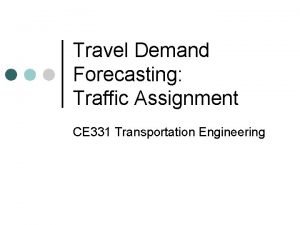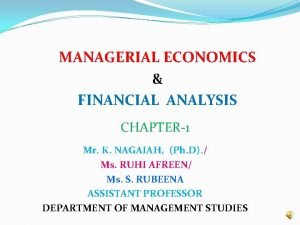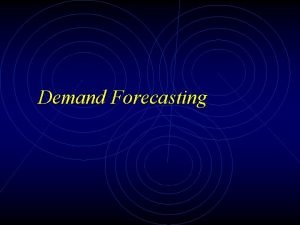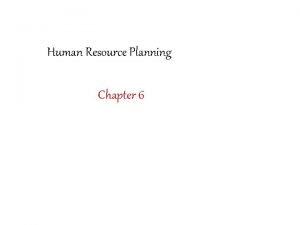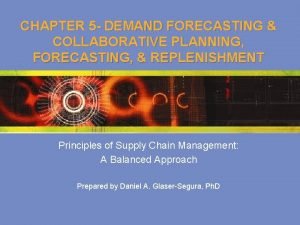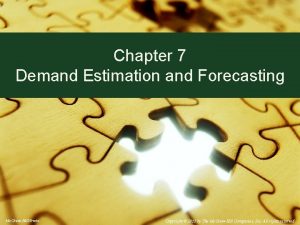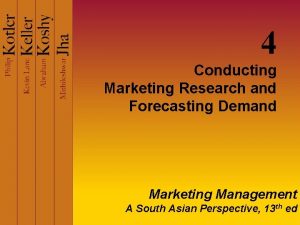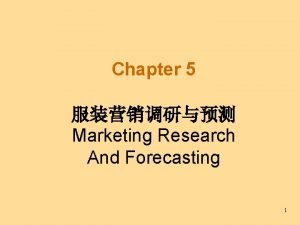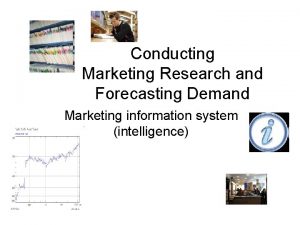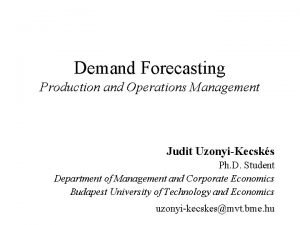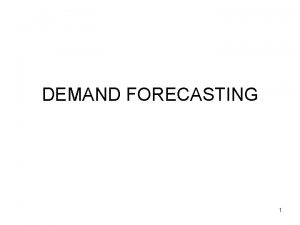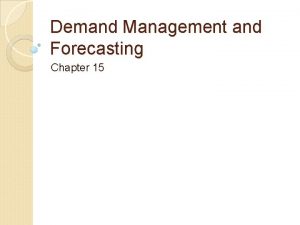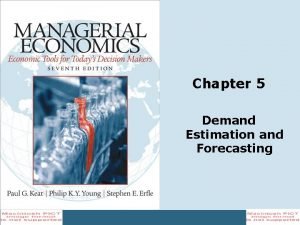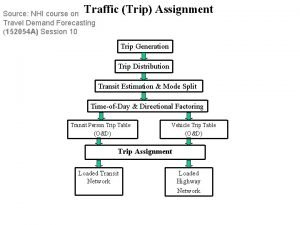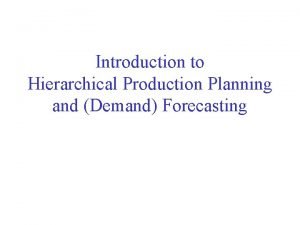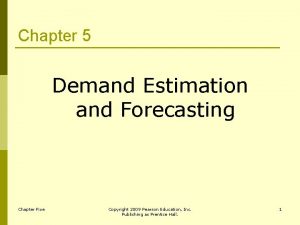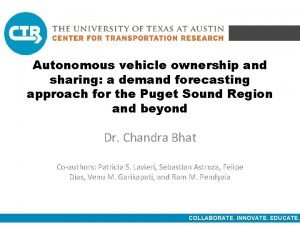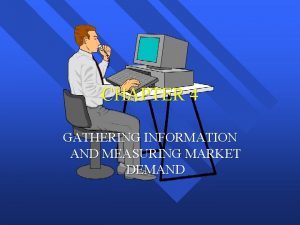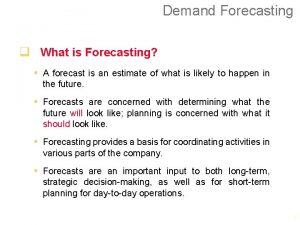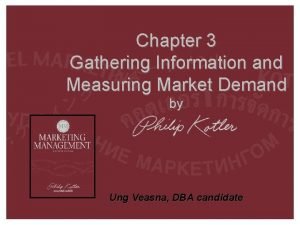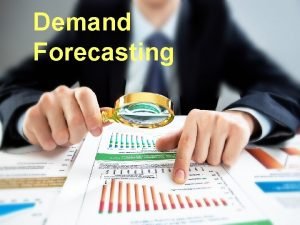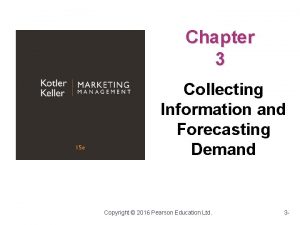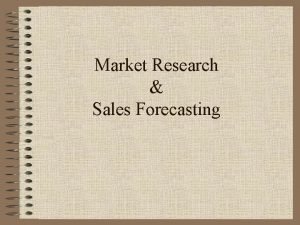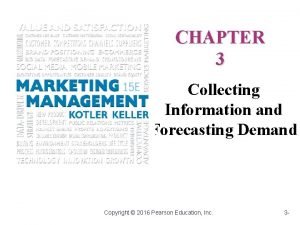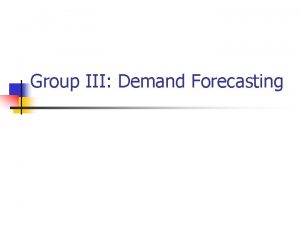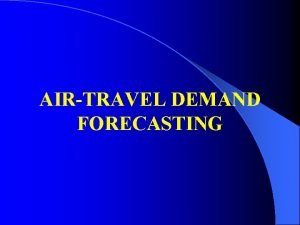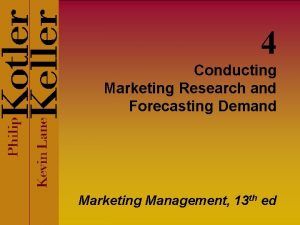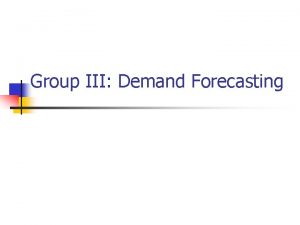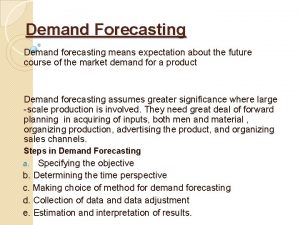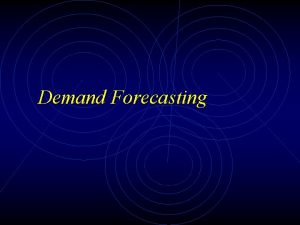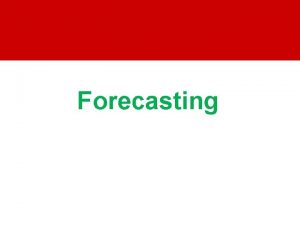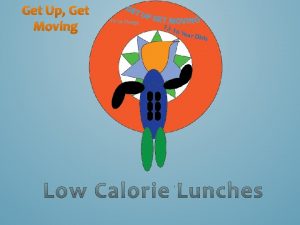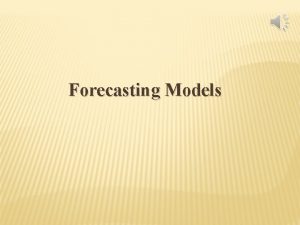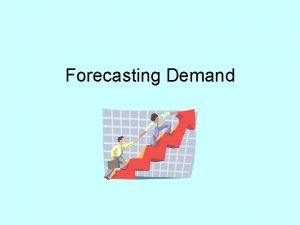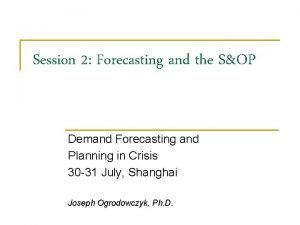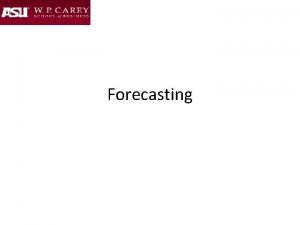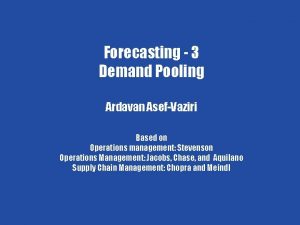DEMAND FORECASTING 1 Demand Forecasting To get an






































- Slides: 38

DEMAND FORECASTING 1

Demand Forecasting • To get an overview of the market and act proactively • To adjust production and avoid over production and under production • Essential for production scheduling, purchase of raw materials, arranging finance and advertising 2

• Process of forecasting DD and sales of a firm’s product: • Firm uses macro forecast of general economic activity (GNP) as inputs for micro forecasts 3

Qualitative Methods • Used for short term forecasts when data are not available • Also for supplementing quantitative forecasts • Surveys on economic intentions can reveal and can be used to forecast future purchase of capital equipment, inventory changes and major consumer expenditures 4

Survey Methods • Complete enumeration (census) vs sample • Questionnaire, interview or observation Opinion Polls: • Consumer Survey • Executive Polling • Sales force polling 5

Survey Methods Buying Intentions of consumers has limited use because - Consumer may not be able to clearly foresee the choice, - Wishful thinking -Answers tailored to impress interviewer - New alternatives may emerge, -Passive because it does not measure variables which are under management control -Intention may not translate into actual buying 6

End-use method Steps: • Identify all possible uses e. g. , as input to other industries, plus direct consumption • Establish technical norms of consumption for each end use • Find out target levels of output in all industries consuming the product- including exports in targeted year for each industry • Likely new developments involving product • Add 7

Survey Methods Expert Opinion Poll: - Market consultants, industry analysts with knowledge of product and the market conditions - Personal insights can be subjective - To avoid the problem of dominant personality, Delphi method 8

Delphi method Developed by Rand Corporation in 1940 s- arriving at consensus - Anonymity -Wide expertise -Effective when there is no urgency but -Difficulty in getting panelists -Requires understanding, skill and knowledge for conceptualising, stimulating discussion and making inferences by researcher. 9

Market Studies and Experiments - Consumer Clinics or controlled lab experiments where consumer is given an amount and expenditure behaviour is observed - Aware of being observed, consumer may not behave naturally - Costly - Not large enough to generalise 10

Market Experiments: • Changes are introduced in select markets and consumer response studied • Gives time for producer to make necessary changes if necessary • Costly errors are avoided 11

QUANTITATIVE METHODS 1. Time Series Method- naïve forecasting - Variables change with time Sources of variation in Time series : Ø Secular Trend Ø Seasonal Changes Ø Cyclical Fluctuations Ø Random or irregular fluctuations 12

Time Series Method. Total variation , say in sales, is the result of all four factors operating together. 13

Time Series Method • Trend Projection • Simplest- projecting the past trend by fitting a straight line to the data either visually or more precisely through regression 14

Least Squares Method- Most widely used time series method Linear Equation of a straight line is Y = a + b. X where Y is the demand X is the time period (no of years), a and b are constants depicting intercept and slope of the line. Calculation of Y for any value of X requires the values of a and b, for which 2 normal equations are prepared: 15

Least Squares Method ΣY = na + b ΣX ΣXY=a ΣX + b ΣX 2 With values of a and b, straight line equation is obtained and forecast is made for Y for given value of X. 16

Time Series Method Smoothing Techniques: These predict values of a time series on the basis of some average of its past values. Useful when time series exhibit little trend or seasonal variations but a great deal of irregular or random variations 17

Time Series Method Moving Average Method: 3 (or 5) monthly/ yearly/ quarterly moving averages computed Average value of the last 3 (or 5) entries becomes the forecast for the next period 18

Time Series Method • Simple moving average gives equal weight to all observations, even though more recent observations are likely to be more important. • Exponential smoothing overcomes this problem. 19

Barometric Forecast: - When data indicates cyclical fluctuations - To predict short term changes in economic activity or turning points - Barometric forecasting is done by NBER and the Conference Board 20

Barometric Forecast - Related variables are categorised into 3 groups- Leading variables: those that change before the actual change - Coincident Variables: Change along with variable - Lag variables: Follow the event - If leading variables are identified, easy to predict actual variables 21

Barometric Forecast PEAK B. din Lea g dent i c n i A. Co le b varia C. Lagging variable PEAK Trough Time 22

Barometric Forecast Leading indicators : • Building permits, new private housing units • Number of loan applications • New orders for durable goods for their components and raw materials • Index of consumer expectations • Stock prices 23

Barometric Forecast Coincident indicators : • Rate of unemployment • GDP • Industrial production • Manufacturing and trade sales 24

Barometric Forecast • Lagging Indicators: • Commercial and industrial loans outstanding • Change in consumer price index for services 25

Commonly used Macroeconomic Predictive Indicators: • Hiring • Consumer spending • Consumer confidence • Purchase managers’ index • Bank Lending • Shipping activity 26

Barometric Forecast Problems: • Only used for short term forecasting • Difficult in identifying and getting data on variables 27

• Hiring, consumer spending, consumer confidence, purchase managers’ index, bank Lending, Shipping activity 28

Econometric Modelling for Forecasting • Identifying and measuring the relationship • Can be single variable or multivariate regression model • Single equation models for a firm’s demand; Large multiple equation models for the entire economy 29

Regression Analysis Steps in Regression Analysis 1. Identification of relevant explanatory/ independent variables 2. Collection of data on variable under forecast and its determinants- can be time series or cross section 3. Specifying the appropriate demand function for Estimation (Linear, log linear etc) 30

Regression Analysis • Dx = a 0+ a 1 Y+ a 2 Px+a 3 Py+a 4 A+ε • a 1, , a 2 , a 3, a 4: respective partial regression coefficients- measure of elasticitymeasure both magnitude and direction of change • Ε: Error term shows effect of omitted variables or any error in measurement 31

Regression Analysis 4. Estimating the above function by using the collected data on the variable and its determinants to get the values of the coefficients as well as coefficient of determination, R 2. Higher the R 2 better the fit 5. Forecast for the variable, given the estimated values of coefficients e. g. , you can forecast expected sales if you know the future Y, P, A P of substitute etc 32

Regression Analysis • Not subjective like the qualitative methods • Based on causal relationships and produces accurate results • Method is consistent • Forecasts both direction and magnitude of change BUT • Uses complex calculations • Costly and time consuming 33

Simultaneous Equations Method • Involves specification of a number of economic relationships, one for each behavioral variable and its estimation. • Method leads to a complete model which can explain the behavior of all the variables 34

Risks in Demand Forecasting • Inadequate analysis of the market- include all potential users of a product • Forecasting all drivers of market in each segment • Unforeseen events • Petroleum industry 35

Sums in Forecasting Data for demand for watches for 5 years is given, estimate demand for 2014: Year 2005 2006 2007 2008 2009 No 120 130 150 140 160 36

Sum in Forecasting Year X Y X 2 Y 2 XY 2005 1 120 1 14400 120 2006 2 130 4 16900 260 2007 3 150 9 22500 450 2008 4 140 16 19600 560 2009 5 160 25 25600 800 Total 15(ΣX) 700 (ΣY) n=5 55 (ΣX 2 ) 99000 2190 (ΣXY) 37

Sums in Forecasting Normal equation: Y= a + b. X (i) ΣY= na + b ΣX (ii) ΣXY = aΣX + b ΣX 2 (iii) 700= 5 a + 15 b (iv) 2190=15 a + 55 b (v) Solving (iv) and (v) we get, 10 b= 90 b=9; Substituting the value of b in (iv) 700=5 a+15* 9 5 a=565 a=113 Y=113+9 X. For year 2013, X will be 10. Y 2013= 113 + 9 * 10 = 203 watches 38
 Get into get out of
Get into get out of One direction song one thing
One direction song one thing Demand forecasting managerial economics
Demand forecasting managerial economics Get up get moving quiz
Get up get moving quiz Get focused get results
Get focused get results Get up get moving quiz
Get up get moving quiz Germer
Germer Get up get moving quiz
Get up get moving quiz Pseudocode examples
Pseudocode examples Travel demand forecasting
Travel demand forecasting Statistical methods of demand forecasting
Statistical methods of demand forecasting Limitations of demand forecasting
Limitations of demand forecasting Supply forecasting in human resource planning
Supply forecasting in human resource planning Elements for forecast collaboration
Elements for forecast collaboration Demand estimation and forecasting
Demand estimation and forecasting Conducting marketing research and forecasting demand
Conducting marketing research and forecasting demand Forecasting and demand measurement in marketing
Forecasting and demand measurement in marketing Collecting information and forecasting demand summary
Collecting information and forecasting demand summary Demand forecasting in operations management
Demand forecasting in operations management Chain ratio method example
Chain ratio method example Simultaneous equation method in demand forecasting
Simultaneous equation method in demand forecasting Demand forecasting objectives
Demand forecasting objectives Barometric methods are used to forecast
Barometric methods are used to forecast Demand forecasting
Demand forecasting Hierarchical production planning
Hierarchical production planning What is demand forecasting and estimation
What is demand forecasting and estimation Forecasting demand for autonomous vehicles
Forecasting demand for autonomous vehicles Demand measurement in marketing
Demand measurement in marketing Importance of forcasting
Importance of forcasting Measuring market demand
Measuring market demand Forecasting advantages
Forecasting advantages Forecasting and demand measurement in marketing
Forecasting and demand measurement in marketing Chain ratio method of demand forecasting
Chain ratio method of demand forecasting Collecting information and forecasting demand
Collecting information and forecasting demand Hotel demand forecasting
Hotel demand forecasting Demand forecasting objectives
Demand forecasting objectives Capturing marketing insights
Capturing marketing insights Air travel demand forecasting
Air travel demand forecasting Conducting marketing research and forecasting demand
Conducting marketing research and forecasting demand









